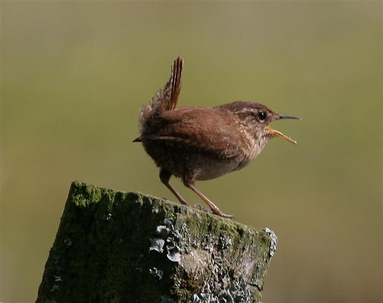Communal Roosts

At the end of a winter’s day, many species of birds can be seen gathering together before dusk. Starlings, Jackdaws, crows and gulls among others will form into flocks and can be seen flying off together. Starlings can sometimes make up spectacular swirling groups. In the Bird Notes last winter, the Wren was featured. The human occupants of one home in Blackwaterfoot had put up a pouch and had the pleasure of watching a string of Wrens piling into the little shelter each evening. All of these birds are preparing to roost communally. Why do they do this?
A study of roosting Long-tailed Tit, a social species that lives in flocks during the non-breeding season, showed that their roosting huddles were in lines, in which individuals competed to avoid occupying the outside positions at either end of the roost. Using observations of eighteen temporarily captive flocks of Long-tailed Tits, it was found that, on average, Long-tailed Tits lost about 9% of their body mass overnight, and that individuals occupying the peripheral positions in a roost lost significantly more mass than those occupying inner positions.
Overnight mass loss was related to minimum temperature. This result suggests that Long-tailed Tits may be using roosting together to reduce energy costs.
A second benefit from communal roosting is thought to be that the eyes and ears of the group are more likely to detect possible predators and it is safer in a group than being an individual.
A study of Hooded Crows seemed to suggest yet another benefit to communal roosting. In this three year study, thirty four radio-tagged, free-ranging, flock-living Hooded Crows were used, along with a “two day movable feast” where there was lots of food in a specified place for two days. There were two major findings. First, a crow was more likely to visit the experimental food patch on the second day when it had been there on the first day. Second, when a crow had not been at this food patch on the first day, it was more likely to visit it on the second day if it had roosted together with a crow that had been there on the first day, but only if this knowledgeable roost-mate returned to the food patch on the second day. This result suggests that communal roosting might help to improve the foraging efficiency in Hooded Crows.
Thus three main benefits are thought to underlie communal roosting in birds: reduction in the risk of starvation by lowering the energy required to survive the night, a decrease in predation risk, and an improved ability to find food.
Video Footage of Communal Roosting Wrens
This is a link to some footage taken by a couple in Blackwaterfoot who share their home with roosting Wrens. The footage was shot in a roosting pocket that the couple put up on the east side of their house. On occasions up to 18 Wrens make use of the pouch In addition, they have had up to 13 Wrens roosting underneath their balcony in a robin nestbox. During periods of bitterly cold, frosty weather these refuges have become very popular.